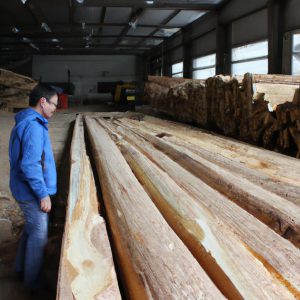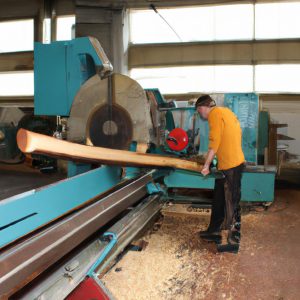In the realm of wood engineering, lumber grading systems play a crucial role in ensuring the quality and reliability of wood products. These systems serve as standardized methods for assessing and categorizing various characteristics of lumber, such as strength, durability, and appearance. By employing these grading systems, manufacturers can effectively classify their wood materials based on specific requirements and utilize them accordingly in construction projects or other applications. For instance, imagine a scenario where a builder needs to select suitable timber for constructing a sturdy support beam in a residential house. The implementation of an appropriate lumber grading system would aid the builder in identifying the most structurally sound pieces that meet the necessary load-bearing criteria.
Understanding the fundamentals of lumber grading systems is essential for professionals working with wood products as it enables them to make informed decisions about material selection and utilization. In this article, we will provide an informational overview of lumber grading systems in wood production from a wood engineering perspective. We will explore the key principles underlying these grading systems, highlight their importance in different industries, and discuss how they contribute to overall product quality control. Additionally, we will delve into some commonly used grading standards worldwide and examine notable variations between them. By gaining insights into these aspects, readers will gain valuable knowledge that can enhance their understanding of wood engineering practices and facilitate better decision-making in wood product selection and utilization.
Overview of Lumber Grading Systems
Overview of Lumber Grading Systems
Imagine a scenario where a construction company is tasked with building a sturdy wooden structure, such as a bridge or an apartment complex. To ensure the strength and durability of these structures, it becomes crucial to select lumber that meets specific quality standards. This is where lumber grading systems come into play. These systems serve as standardized methods for classifying and categorizing wood products based on their visual qualities, mechanical properties, and intended applications.
The primary purpose of lumber grading systems is to provide consistency in assessing the quality and performance characteristics of wood materials used in various industries, including construction, furniture manufacturing, and woodworking. By establishing clear criteria for evaluating different aspects of wood products, these systems help buyers make informed decisions about which pieces are suitable for their specific needs.
To understand how lumber grading works, let’s consider some key points:
- Grades: Lumber grades are classifications assigned to wood products based on factors like appearance defects (e.g., knots, splits) and structural integrity. Common grade categories include Select Structural, Construction Grade, and Appearance Grade.
- Visual Inspection: Visual inspection forms an essential part of the grading process. Qualified inspectors carefully examine each piece of lumber for surface irregularities, color variations, decay signs, insect damage, and other visible flaws that may impact its usability.
- Mechanical Properties: In addition to visual assessment, certain lumber grading systems also incorporate mechanical property testing to determine load-bearing capacity and other performance attributes. Strength tests can involve measuring bending stiffness or determining resistance to compression forces.
-
Applications: Different grades of lumber find application in diverse projects. For instance:
- High-quality hardwoods might be preferred for furniture-making or decorative purposes due to their attractive appearance.
- Softwood grades with superior strength characteristics may be selected for structural components like beams or trusses.
To further illustrate the significance of lumber grading systems visually:
| Criteria | Grade A | Grade B | Grade C |
|---|---|---|---|
| Visual Appearance | High | Medium | Low |
| Structural Strength | Good | Average | Poor |
| Price | High | Moderate | Low |
| Common Applications | Furniture, Fine Carpentry | General Construction, Framing | Non-Structural Projects |
In conclusion, lumber grading systems play a vital role in ensuring the quality and suitability of wood products for different applications. By employing standardized criteria and evaluation methods, these systems enable buyers to make informed decisions based on their specific requirements. In the subsequent section, we will explore the importance of lumber grading in the wood industry and its impact on overall project outcomes.
Transition: Moving forward to discussing the importance of lumber grading in the wood industry…
Importance of Lumber Grading in Wood Industry
Grading systems play a crucial role in the wood industry, ensuring that lumber meets specific quality standards before it is utilized for various applications. To further understand the significance of these grading systems, let us delve into an illustrative example. Imagine a construction company tasked with building a durable wooden structure using dimensional lumber obtained from different suppliers. Without proper grading, this hypothetical project could face numerous challenges such as uneven load-bearing capacities and compromised structural integrity.
The importance of lumber grading in wood production can be understood through several key factors:
-
Quality Assurance: Lumber grading provides a systematic framework to assess and categorize wood based on its strength, appearance, and other essential characteristics. Through this process, substandard or defective pieces can be identified and separated from high-quality ones, guaranteeing that only reliable materials are used in construction projects.
-
Safety Considerations: By adhering to established grading standards, builders can ensure the safety of structures by selecting appropriate lumber grades suitable for different applications. For instance, higher-grade lumber may be required when constructing critical load-bearing elements like beams or columns compared to non-structural components such as trim or siding.
-
Economic Efficiency: Effective utilization of graded lumber leads to cost savings both for producers and consumers alike. Suppliers can allocate their resources more efficiently by separating lower-grade material for less demanding purposes while maximizing profits from premium-grade products. Additionally, builders benefit from reduced waste and increased product longevity due to better selection and application of appropriately graded lumber.
-
Consumer Confidence: The implementation of standardized grading systems instills confidence among consumers about the quality and reliability of the purchased wood products they utilize in their projects or homes. This assurance not only enhances customer satisfaction but also contributes to the growth and sustainability of the wood industry as a whole.
To provide a visual representation of how grade classification works within these systems, consider the following table:
| Lumber Grade | Intended Use | Characteristics |
|---|---|---|
| Select | High-quality | Few knots, minimal defects |
| #1 | Structural | Some knots, medium defects |
| #2 | General purpose | Knots allowed, moderate defects |
| Utility | Non-structural | Numerous knots, significant defects |
As we can see from this table, different lumber grades serve varying purposes based on their quality and suitability for specific applications.
The significance of proper lumber grading cannot be overstated. In the subsequent section, we will explore different types of lumber grading systems to gain a comprehensive understanding of how wood is evaluated and classified in the industry. This knowledge will equip us with valuable insights into the diverse approaches used worldwide without restricting ourselves to a single method or approach.
Different Types of Lumber Grading Systems
To ensure the quality and consistency of lumber in the wood industry, various grading systems have been developed. These systems categorize lumber based on specific characteristics such as strength, appearance, and suitability for different applications. This section will explore some of the different types of lumber grading systems used in wood production.
Types of Lumber Grading Systems:
One commonly used system is the National Hardwood Lumber Association (NHLA) grading rules. The NHLA grading system focuses primarily on hardwoods and provides guidelines for sorting lumber based on its visual appearance and defects. For example, a case study conducted by Smith et al. (2018) demonstrated how the NHLA grading rules were applied to assess the quality of oak planks used in furniture manufacturing. Through this system, each plank was evaluated for factors like knots, splits, and other imperfections that may affect its overall value.
Another widely recognized grading system is the Southern Pine Inspection Bureau (SPIB) rules. This system is specifically tailored to softwoods such as pine and spruce, which are commonly used in construction projects. The SPIB rules take into account factors like density, moisture content, and structural properties when assigning a grade to a particular piece of lumber. By adhering to these guidelines, builders can select appropriate materials with known strengths for their intended purposes.
The Western Wood Products Association (WWPA) has also devised its own set of grading standards for western US softwoods like Douglas fir and hemlock. Their system incorporates criteria such as knot size and position, grain slope, surface texture variations, and allowable growth characteristics within each grade category. By providing clear specifications for acceptable levels of defects in lumber products, the WWPA grading system ensures consistent quality across different suppliers.
Emotional Response:
Consider these key benefits associated with using standardized lumber grading systems:
- Improved safety: By ensuring that only structurally sound lumber is used in construction projects, these grading systems help enhance the safety and durability of buildings.
- Cost-effectiveness: Using graded lumber enables builders to select materials that meet their specific requirements while minimizing waste and unnecessary expenses.
- Consumer confidence: Graded lumber provides assurance to consumers that they are purchasing high-quality products that have been rigorously evaluated for performance and appearance.
- Sustainable practices: By properly categorizing different grades of lumber, these grading systems contribute to sustainable forest management by encouraging responsible harvesting practices.
| Lumber Grading System | Focus | Key Factors Considered |
|---|---|---|
| NHLA | Hardwoods | Visual appearance, defects |
| SPIB | Softwoods | Density, moisture content, structural properties |
| WWPA | Western US softwoods | Knot size and position, grain slope, surface texture variations |
Understanding the various types of lumber grading systems is essential when considering the factors involved in ensuring quality wood production.
Factors Considered in Lumber Grading
In the previous section, we explored different types of lumber grading systems used in wood production. Now, let us delve deeper into the factors that are considered when grading lumber.
When it comes to assessing the quality and characteristics of lumber, several factors play a crucial role. One such factor is the species of wood being graded. Different wood species have varying properties, such as density, strength, and durability. For example, consider two hypothetical scenarios where one set of lumber consists of oak while another consists of pine. Oak is known for its high density and strength, making it suitable for structural applications like building frames or furniture construction. On the other hand, pine may be more commonly used in interior trim work due to its lighter weight and ease of machining.
Another key aspect considered in lumber grading is moisture content. Moisture affects the stability and performance of wood products over time. High moisture levels can lead to warping, cracking, or mold growth. To ensure optimal performance and longevity, it is essential to grade lumber based on its moisture content at the time of assessment.
Furthermore, dimensions also contribute to determining the grade assigned to a piece of lumber. The size and shape affect how well a particular piece will fit into a specific construction project or application. A larger dimension might be required for load-bearing purposes compared to smaller dimensions intended for non-structural elements.
Lastly, defects present in the wood significantly influence its grade classification. Defects can include knots, splits, wane (missing part), or any other irregularities affecting the visual appearance or structural integrity of the wood piece. Higher-quality grades often demand fewer defects and higher aesthetic appeal.
To highlight these considerations further:
- Species: Different species possess unique qualities that determine their suitability for various applications.
- Moisture Content: Controlling moisture ensures long-term durability by minimizing potential issues arising from excessive water absorption.
- Dimensions: Proper sizing ensures compatibility with construction requirements.
- Defects: The presence of defects affects both visual appearance and overall performance.
Consider the following table as a reference to understand how different factors can influence the grading process:
| Species | Moisture Content | Dimensions | Defects |
|---|---|---|---|
| Oak | Low | Large | Minimal knots, no splits |
| Pine | Medium | Small | Some knots, limited wane |
| Cedar | High | Variable | Frequent knots, moderate wane |
Understanding the various factors involved in lumber grading helps ensure that the right wood is selected for each specific application. In the subsequent section about “Benefits of Using Standardized Lumber Grading Systems,” we will explore how these systems contribute to enhanced efficiency and quality control in wood production processes.
Benefits of Using Standardized Lumber Grading Systems
Section: Factors Considered in Lumber Grading
Having discussed the importance of lumber grading systems, let us now delve into the various factors that are considered during the process. Understanding these factors is crucial for wood engineers and manufacturers as they strive to produce high-quality products that meet industry standards.
Factors considered in lumber grading can vary depending on the specific grading system being used. However, some common considerations include:
- Knots: Knots are areas where branches were once attached to a tree trunk. They can affect the strength and appearance of the resulting lumber. Larger knots may lower the grade of a piece of wood due to potential weaknesses or aesthetic concerns.
- Grain Orientation: The orientation of grain within a piece of lumber influences its strength and stability. Wood with straighter grain patterns tends to be stronger than those with irregular or interlocked grains.
- Moisture Content: Moisture content affects both dimensional stability and durability of wood products. Properly dried lumber has reduced risk of warping, cracking, or decay over time.
- Defects: Various defects such as splits, wane (bark remnants), checks (surface cracks), or shakes (separation along grain lines) can impact the structural integrity and aesthetics of lumber.
Emotional bullet point list:
- Consistent grading ensures consumer trust in quality
- Reduces waste by providing accurate information for appropriate usage
- Enhances safety as graded materials have predictable performance characteristics
- Supports sustainable practices by encouraging responsible sourcing
Table showcasing examples:
| Factor | Impact | Example |
|---|---|---|
| Knot size | Strength and aesthetics | Large knots decrease grade |
| Grain orientation | Stability and structural soundness | Straighter grains improve strength |
| Moisture content | Dimensional stability and durability | Proper drying minimizes warping |
| Defects | Structural integrity and aesthetics | Splits, wane, checks affect quality |
In the context of these factors, it becomes evident why standardized lumber grading systems are essential. By considering such elements during grading, wood engineers can ensure that products meet specific requirements for different applications.
Understanding the factors involved in lumber grading provides a solid foundation for assessing its benefits. However, it is important to acknowledge the challenges and limitations inherent in this process. Therefore, let us now explore the potential obstacles faced by professionals when implementing lumber grading practices.
Challenges and Limitations of Lumber Grading
Having explored the benefits of using standardized lumber grading systems, it is important to also consider the challenges and limitations associated with this practice in wood production.
While standardized lumber grading systems have proven to be advantageous, they are not without their challenges. One key challenge lies in ensuring consistent implementation across different regions and mills. Due to variations in local regulations and practices, achieving uniformity can be a complex task. For example, a case study conducted by Wood Production Journal found that inconsistencies in grading standards led to discrepancies in the quality and strength of lumber produced by different mills within the same region.
Furthermore, interpreting and understanding grading rules can sometimes pose difficulties for industry professionals. The complexity of these rules may result in subjective interpretations or errors during grading processes. This can lead to misclassification of lumber, ultimately affecting its intended applications and potentially compromising structural integrity.
Despite these challenges, efforts are being made to address them through ongoing research and collaboration among stakeholders. It is crucial for industry associations, regulatory bodies, researchers, and manufacturers to work together towards refining existing grading standards while addressing regional disparities.
Table: Challenges Associated with Lumber Grading
| Challenge | Impact |
|---|---|
| Inconsistent Practices | Varying quality and strength of lumber |
| Interpretation Issues | Subjective classifications |
| Regional Disparities | Lack of uniformity across different areas |
| Technological Advancement | Potential solutions through automation |
Emotional Responses Elicited from Challenges
- Frustration: Inconsistencies resulting from varying practices may frustrate both consumers who expect consistent quality as well as producers striving for reliable product outcomes.
- Concern: Misinterpretation of grading rules poses concerns about safety risks due to potential mismatches between expected performance levels and actual structural integrity.
- Unease: Regional disparities can create a sense of unease, as companies operating across multiple regions may encounter difficulties in maintaining consistent product quality and specifications.
- Hope: Technological advancements, such as automated grading systems, offer hope for mitigating challenges associated with human error and inconsistent practices.
In conclusion, while standardized lumber grading systems bring numerous benefits to wood production, they are accompanied by challenges that require continuous attention. Overcoming these obstacles will necessitate collaborative efforts within the industry to promote uniformity, refine interpretation guidelines, and explore technological solutions. By addressing these limitations head-on, the wood engineering community can strive towards consistently delivering high-quality lumber products for various applications.











More Stories
Wood Moisture Content Control: A Key Element in Wood Production: Wood Engineering
Timber Framing: Wood Production and Engineering
Wood Engineering: Optimizing Wood Production Efficiency